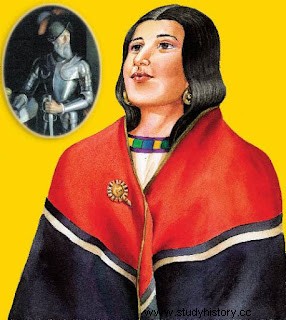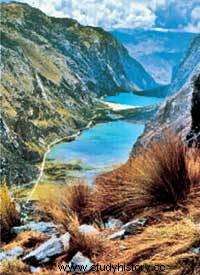 Recreation of Inés Huaylas Yupanqui What happened was that in the last decades of the fourteenth century, Túpac Inca Yupanqui arrived at that place, on his journey to conquer the "huaras", "piscobambas" and "conchucos", who fulfilled his mission, although with great effort. and with a formidable troop that had thousands of soldiers, due to the fierce resistance put up by the inhabitants of the eastern side of the Cordillera Blanca. Among the trophies that he brought to Cusco was the daughter of one of the curacas. Later, with that ñusta she had Huayna Cápac one of his daughters. In the year 1532 the men from the West arrived. Pizarro and his small army possessed firearms, horses, armor, swords, and dogs trained to hunt men. They were warriors recently trained in the fight and expulsion of the Arabs, of the conquest of New Spain, in addition, firm believers that they were the chosen ones of God. Helped by Huascarist Indians they conquered a great empire capturing Atahualpa Inca Yupanqui. The young ñusta, who belonged to the court of the imprisoned Inca, was baptized at the age of 17, receiving the name of Inés Huaylas Yupanqui.
Recreation of Inés Huaylas Yupanqui What happened was that in the last decades of the fourteenth century, Túpac Inca Yupanqui arrived at that place, on his journey to conquer the "huaras", "piscobambas" and "conchucos", who fulfilled his mission, although with great effort. and with a formidable troop that had thousands of soldiers, due to the fierce resistance put up by the inhabitants of the eastern side of the Cordillera Blanca. Among the trophies that he brought to Cusco was the daughter of one of the curacas. Later, with that ñusta she had Huayna Cápac one of his daughters. In the year 1532 the men from the West arrived. Pizarro and his small army possessed firearms, horses, armor, swords, and dogs trained to hunt men. They were warriors recently trained in the fight and expulsion of the Arabs, of the conquest of New Spain, in addition, firm believers that they were the chosen ones of God. Helped by Huascarist Indians they conquered a great empire capturing Atahualpa Inca Yupanqui. The young ñusta, who belonged to the court of the imprisoned Inca, was baptized at the age of 17, receiving the name of Inés Huaylas Yupanqui.THE MARQUIS FOUND A PRINCESS Pizarro fell in love with her and chose her as her partner, eventually having two children with her:Francisca Pizarro Yupanqui and Gonzalo Pizarro Yupanqui. King Carlos V, by decree of Monzón dated October 12, 1537, ordered that they be considered legitimate. The direct descendants of these reached the fifth generation. Doña Luisa Vicenta Pizarro y Fernández-Somoza, the last heirs of Pizarro and Huaylas, died in 1756. Don Francisco Pizarro had another son:Francisco Pizarro Yupanqui, by another ñusta, Doña Angelina Yupanqui, sister of Doña Inés and Huascar. The Inca Garcilaso de la Vega says of him, in his "Royal Commentaries of the Incas", that he was "a great friend and emulator of mine, because, when we were eight or nine years old, his uncle Gonzalo Pizarro made us run and jump".
THE CONQUERORS IN ANCASH
 Laguna de Llanganuco, in the Callejón
Laguna de Llanganuco, in the Callejón of Huaylas, area where Doña Inés.Francisco was from Pizarro, after the capture and death of the last Inca emperor in Cajamarca (current Cajamarca), on his trip to Cusco, entered the Áncash region, through the Pallasca area. On August 23, 1533, he crossed the Tablachaca River with his entourage made up of Father Valverde, Doña Inés de Huaylas Yupanqui, Diego de Almagro, the new Inca Inti Cussi Túpac Huallpa Yupanqui, General Chalcochima, as a prisoner, the secretary of the conqueror Pedro Sancho de la Hoz, 400 men, thousands of auxiliary Indians, blacks, Moors and their dogs. A long column of indigenous freighters followed them with gold, silver and supplies. The fertile valley of the Huaylas, due to its strategic geographical location, would be an obligatory step for the conquerors. And so, without confirming the data, on January 20, 1572, Sunday, the town of Huaraz would be founded under the patronage of San Sebastián. , by Captain Alonso de Santoyo y Valverde. Huaraz assumes on that date the seat of the Corregimiento of Huaylas until 1784. Between that date and 1821, it is the capital of the party or sub-delegation of Huaylas. On February 12, 1821, by provision of the Provisional Regulation of Huaura, with the signature of General José de San Martín, in the midst of the War of Independence, it became the capital of the department of Huaylas.
THE FUTURE OF DOÑA INÉS After his trip to Cusco, Pizarro searches the Andean coast for a safe place to found the capital of his government. He founded the City of the Kings on January 18, 1535 and gave it the category of capital city. The link with Inés Huaylas provided Pizarro in Cusco with the support of Manco Inca, brother of the ñusta, against the resistance attempts of Quito generals. We do not know how she reacted to the desecration and looting of sacred Inca sites. Some versions assure that she Inés collaborated with the rebellion of Manco Inca in 1536. It is even assured that Inés facilitated the Inca's escape from Cusco, an escape that allowed Manco Inca to gather an army and lay siege to the city. In any case, the link with the leader of the conquest remained unchanged until 1538.
WHY DID THE PIZARRO-YUPANQUI UNION BREAK? Then, suddenly, the marriage was broken, in the Inca way, and Inés was soon married in Lima, before the altars, with another conqueror, Francisco de Ampuero, one of those who had been present at the capture of Atahualpa Inca Yupanqui. The version persisted for many years that Pizarro himself urged them to marry, sword in hand, "after having surprised them as lovers." Pizarro died in the year 1542, as we know, assassinated by the almagristas. “… He did not include Inés or her children in his will, although they would later receive favors for his condition. The children were sent to Spain by Ampuero under the protection of the king. Francisco de Ampuero became mayor of Lima and gave his Indian wife a fortune and a good name. Francisco de Ampuero had three children with her and when he died he left her property to her wife. Inés Huaylas survived her widowhood for many years and died in Lima in good esteem and with numerous descendants. José Antonio del Busto recounts that the illustrious Huaylina was known as 'the mother of the Ampueros', by the 'many and powerful' Lima Creoles of that name they inherited his blood” (“Áncash”, La República, 2003).
THE DESCENDANTS OF THE OTHER PIZARROS Hernando Pizarro had no children. Juan had a daughter, whom he called Francisca Pizarro, whom he married years later with the Spaniard Garcilópez Gonzáles, with whom he had two daughters. Gonzalo had three children, two of whom died in infancy and only Inés survived, a daughter born to a ñusta from the ayllu Iunquill Túpac Yupanqui, from the court of Inti Cussi Túpac Huallpa Yupanqui. In summary, the 4 Pizarros only had 7 American children.
HOW WOULD THE WOMEN OF THE PIZARROS FEEL? It must have been a hard predicament for the wives, concubines or lovers of the conquerors to be by their side, passively responding to the caresses of men in whom they saw the destroyer of their brothers and other relatives, as well as the plunderer of their nation.
Lima, March 6, 2009. Julio R. Villanueva Sotomayor
